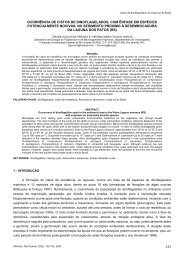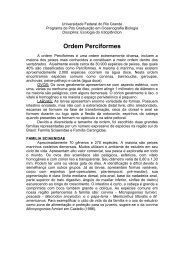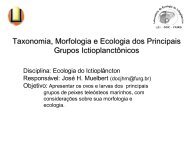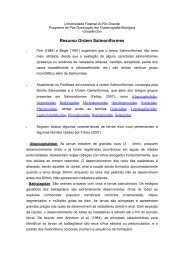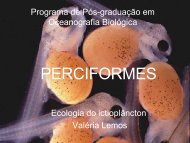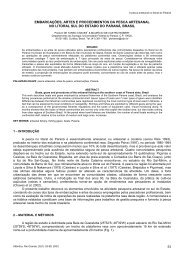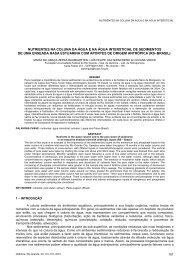pdf - Laboratório de Ecologia do Ictioplâncton - Furg
pdf - Laboratório de Ecologia do Ictioplâncton - Furg
pdf - Laboratório de Ecologia do Ictioplâncton - Furg
Create successful ePaper yourself
Turn your PDF publications into a flip-book with our unique Google optimized e-Paper software.
141<br />
FICHA DE COLETA REDE MÚLTIPLA<br />
CRUZEIRO: _________ ESTAÇÃO: __________ DATA: ____/____/_______<br />
POSIÇÃO: Lat _____°_________S Long _____°_______W PROF: _________m<br />
HORAL LOCAL: ___________<br />
TEMPO <strong>de</strong> Descida:____ min ______s<br />
HORA GMT:___________<br />
<strong>de</strong> subida:____ min ______s<br />
Lance n°: _____________ Hora:____________ Coleta: ____/____<br />
REDE 1: Vol. Filt.:_______m³ Prof: ______________ Frasco(s): _____ ____<br />
Obs:______________________________________________________<br />
REDE 2: Vol. Filt.:_______m³ Prof: ______________ Frasco (s): _____ ____<br />
Obs:______________________________________________________<br />
REDE 3: Vol. Filt.:_______m³ Prof: ______________ Frasco (s): _____ ____<br />
Obs:______________________________________________________<br />
REDE 4: Vol. Filt.:_______m³ Prof: ______________ Frasco (s): _____ ____<br />
Obs:______________________________________________________<br />
REDE 5: Vol. Filt.:_______m³ Prof: ______________ Frasco (s): _____ ____<br />
Obs:______________________________________________________<br />
Códigos da Coleta: 0/0 Amostra feita/Fluxômetro li<strong>do</strong><br />
1/0 Parte da amostra perdida/Fluxômetro li<strong>do</strong><br />
0/9 Amostra feita/ Fluxômetro não li<strong>do</strong> ou com <strong>de</strong>feito<br />
1/9 Parte da amostra perdida/ Fluxômetro não li<strong>do</strong> ou com <strong>de</strong>feito<br />
Estes são os procedimentos <strong>de</strong> coleta e armazenagem à bor<strong>do</strong>. Vale salientar que os<br />
procedimentos <strong>de</strong> transporte e os <strong>de</strong> laboratório como armazenagem, observação,<br />
triagem e tratamento <strong>de</strong> da<strong>do</strong>s também são muito importantes, mas não foram<br />
aborda<strong>do</strong>s neste manual.<br />
11. Referências bibliografias<br />
Ahlstrom, E.H. (1948). A record of pilchard eggs and larvae collected during surveys ma<strong>de</strong> in<br />
1939 to 1941. United States Fish and Wildlife Service. Special Scientific Report, 54, 76.<br />
Arnold, E.L. (1952). High speed plankton samplers I: a high speed plankton sampler (Mo<strong>de</strong>l<br />
Gulf 1-A). United States Fish and Wildlife Service Special Scientific Report Fisheries, 88, 1–<br />
6.<br />
Arnold, E.L. (1959). The Gulf V plankton sampler. United States Fish and Wildlife Service<br />
Circular, 62, 111–113.<br />
Aron, W. (1958). The use of a large capacity portable pump for plankton sampling, with notes<br />
on plankton patchniess. Journal of Marine Research, 16, 158-173.<br />
Baker, A.D., Clarke, M.R., & Harris, M.J. (1973). The N.I.O. combination net (RMT 1 + 8) and<br />
further <strong>de</strong>velopments of rectangular midwater trawls. Journal of the Marine Biological<br />
Association of the United King<strong>do</strong>m, 53, 167–184.<br />
Bé, A.W.H. (1959). A method for rapid sorting of foraminifera from marine plankton samples.<br />
Journal of Paleontology, 33, 5.



